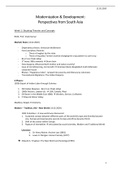12.02.2020
Modernization & Development:
Perspectives from South Asia
Week 1: Situating Theories and Concepts
R103, Prof. Vivek Kumar
Market/ State (12.02.2020)
- Dependency theory: Immanuel Wallerstein
- Core/ periphery theories
o Thesis of neglect by the state
o Thesis of equality: Farmers started changing the crop pattern to cash-crop
- Brij V Lal, Chalo Jahaji
- 3rd wave: 980s onwards → Brain drain
- How diaspora influenced both mother and native country?
- Issue of microfinancing, microcredit → Grameen Bank, Bangladesh multi-billionaire
corporate house
- Bhutan: “Happiness Index”, ramped into poverty and illiteracy by colonizers
- Transnational Migrations: The Indian Diaspora
4-Phases:
1830s Export of Indian Labor through Colonies
1. Old Indian Diaspore - Brij V Lal, Chalo Jahaji
2. 1960s Doctors, Lawyer etc. → USA, Canada, West
3. Oil Boom in the Middle East 1980s → Workers, Service, Craftsmen
4. IT Wave & Silicon Valley
Madhesi, Nepali; Trichotomy
Modern – Tradition, Old – New World (13.02.2020)
1492 Columbus = A new world was discovered
1. Sustained contact between different parts of the world (Europe and Amerika became
one, Europe and Asia became second, Europe and Africa became third)
2. Shift of the center within Europe
3. Rupture of mentalities → articulated by social scientists, Modern and Traditional World
Literature
a. Sir Henry Maine: Ancient Law (1861)
b. Lewis H. Morgan: Ancient Society (1877)
➔ Edward A. Tiryakian: The New World and Sociology (1994)
1
, 12.02.2020
Trajectories of Colonialism
1. Trajectory
a. Colonies of the settlers: Europeans were brought to settle. Migrants were deviant or
structural marginalized.
b. Two centers of production of social sciences in contemporary times: Europe, North
America = Two centers which produce different types of social sciences
2. Trajectory
a. Political independent but continued to be economically dependent (subservient,
deprivation) = Latin American states (Christian religion, European languages →
Replicated types of colonialism within the societies)
3. Trajectory
a. Language and religion are considered to be the aspect of identification (= Africa)
b. 80% of the African states have European languages as their official or leading
language (French, English) and leading religion is Christianity
4. Trajectory
a. Political withdraw of the colonizers. Language of the colonizers have no given any
constitutional influence (Asia)
➔ Imperialism and Social Sciences
- European trading companies ventured across the oceans so as to look for new lands from
where they could buy goods at a cheap price, and carry them back to Europe to sell at higher
prices. The fine qualities of cotton and silk produced in India had a big market in Europe.
- Siddhi is a Sanskrit noun which can be translated as "perfection", "accomplishment",
"attainment", or "success". Swahili is an official language of Tanzania, Uganda and Kenya,
and is used as a lingua franca throughout East Africa
Why did Japan never get colonized by European empires?
- Japan was very far away from Europe and thus not seen as a huge priority. Portugal and
Spain valued their colonies in the Americas, India and Indonesia more as they contributed
immensely to their economies. Japan was far from poor itself, of course, but the European
countries could already extract spices, precious metals, and other valuable trade goods from
their other Asian colonies and from the China trade, so it did not offer that much more in
comparison, and trying to force colonization upon it was practically impossible logistically.
Japan was valuable, sure, but colonizing a large country so far away was going to be
extremely difficult.
- Colonization by force only works if the local population is very poorly armed (the Americas)
or disunited (India and to a point Indonesia). Now, despite the early advantage of the
Europeans in shipbuilding and firearms (and I say early, because the Japanese took to
firearms extremely quickly and soon produced a lot of high-quality handguns), the military
technology and strategy of the Japanese warlords was roughly equal to that of the
Europeans. Early on, they were at war, but at that point the European presence was just
beginning. By the 1580s Japan was mostly unified, and from 1600 on, the Tokugawa
shogunate had an iron grip on the country. This made any attempts for colonization that
much harder. Remember, Portugal was a small country at the best of times - Japan’s
population at the time was nearly 10 times larger!
- Initial contact with the Portuguese and the Spanish did not endear them overmuch to the
Japanese rulers and limited their influence. There was a bit of slave trade involved, even
though the Portuguese king Sebastian ordered it banned in the 1570s (though it was not
2




